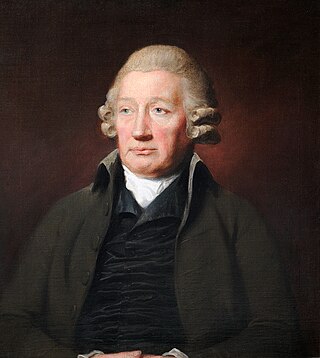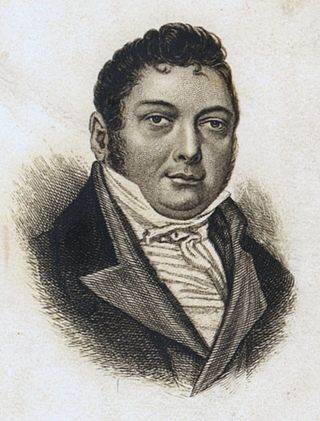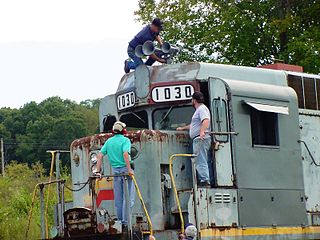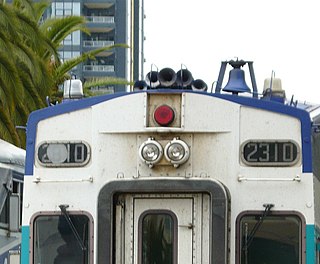Related Research Articles

A steam engine is a heat engine that performs mechanical work using steam as its working fluid. The steam engine uses the force produced by steam pressure to push a piston back and forth inside a cylinder. This pushing force can be transformed by a connecting rod and crank into rotational force for work. The term "steam engine" is most commonly applied to reciprocating engines as just described, although some authorities have also referred to the steam turbine and devices such as Hero's aeolipile as "steam engines". The essential feature of steam engines is that they are external combustion engines, where the working fluid is separated from the combustion products. The ideal thermodynamic cycle used to analyze this process is called the Rankine cycle. In general usage, the term steam engine can refer to either complete steam plants, such as railway steam locomotives and portable engines, or may refer to the piston or turbine machinery alone, as in the beam engine and stationary steam engine.

John "Iron-Mad" Wilkinson was an English industrialist who pioneered the manufacture of cast iron and the use of cast-iron goods during the Industrial Revolution. He was the inventor of a precision boring machine that could bore cast iron cylinders, such as cannon barrels and piston cylinders used in the steam engines of James Watt. His boring machine has been called the first machine tool. He also developed a blowing device for blast furnaces that allowed higher temperatures, increasing their efficiency, and helped sponsor the first iron bridge in Coalbrookdale. He is notable for his method of cannon boring, his techniques at casting iron and his work with the government of France to establish a cannon foundry.
Rail transport terms are a form of technical terminology applied to railways. Although many terms are uniform across different nations and companies, they are by no means universal, with differences often originating from parallel development of rail transport systems in different parts of the world, and in the national origins of the engineers and managers who built the inaugural rail infrastructure. An example is the term railroad, used in North America, and railway, generally used in English-speaking countries outside North America and by the International Union of Railways. In English-speaking countries outside the United Kingdom, a mixture of US and UK terms may exist.

Main components found on a typical steam locomotive include:

PNY Technologies, Inc., doing business as PNY, is an American manufacturer of flash memory cards, USB flash drives, solid state drives, memory upgrade modules, portable battery chargers, computer locks, cables, chargers, adapters, and consumer and professional graphics cards. The company is headquartered in Parsippany-Troy Hills, New Jersey.

Babcock & Wilcox Enterprises, Inc. is an American energy technology and service provider that is active and has operations in many international markets with its headquarters in Akron, Ohio. Historically, the company is best known for their steam boilers.
Combustion Engineering (C-E) was a multi-national American-based engineering firm that developed nuclear steam supply power systems in the United States. Originally headquartered in New York City, C-E moved its corporate offices to Stamford, Connecticut, in 1973. C-E owned over three dozen other companies including Lummus Company, National Tank Company and the Morgan Door Company. The company was acquired by Asea Brown Boveri in early 1990. The boiler and fossil fuel businesses were purchased by Alstom in 2000, and the nuclear business was purchased by Westinghouse Electric Company also in 2000.

A steam whistle is a device used to produce sound in the form of a whistle using live steam, which creates, projects, and amplifies its sound by acting as a vibrating system.

Matthew Murray was an English steam engine and machine tool manufacturer, who designed and built the first commercially viable steam locomotive, the twin-cylinder Salamanca in 1812. He was an innovative designer in many fields, including steam engines, machine tools and machinery for the textile industry.

A destroyer tender or destroyer depot ship is a type of depot ship: an auxiliary ship designed to provide maintenance support to a flotilla of destroyers or other small warships. The use of this class has faded from its peak in the first half of the 20th century as the roles and weaponry of small combatants have evolved.

Elliott Company designs, manufactures, installs, and services turbo-machinery for prime movers and rotating machinery. Headquartered in Jeannette, Pennsylvania, Elliott Company is a wholly owned subsidiary of the Japan-based Ebara Corporation, and is a unit of Elliott Group, Ebara Corporation's worldwide turbomachinery business. Elliott Group employs more than 2000 employees worldwide at 32 locations, with approximately 900 in Jeannette.

A train horn is an air horn used as an audible warning device on diesel and electric-powered trains. Its primary purpose is to alert persons and animals to an oncoming train, especially when approaching a level crossing. They are often extremely loud, allowing them to be heard from great distances. They are also used for acknowledging signals given by railroad employees, such as during switching operations. For steam locomotives, the equivalent device is a train whistle.
McWane, Inc. is one of the world's largest manufacturers of iron water works and plumbing products and one of America's largest privately owned companies. The company manufactures a host of different products including ductile iron pipe and fittings, cast iron soil pipe and fittings, heavy duty couplings, utility poles, network switches, monitoring equipment and related products. McWane is also a manufacturer of pressurized cylinders for the storage of propane and other gases through its Manchester Tank and Equipment Company division, as well as fire protection systems and extinguishers through its Amerex subsidiary.
On 23 October 1989 at approximately 1:05 PM Central Daylight Time, a series of explosions occurred at Phillips Petroleum Company's Houston Chemical Complex (HCC) in Pasadena, Texas, near the Houston Ship Channel. The initial blast registered 3.5 on the Richter scale, and the resulting fires took 10 hours to bring under control, as efforts to battle the fire were hindered due to damaged water pipes for the fire hydrants from the blast. The initial explosion was found to have resulted from a release of extremely flammable process gasses used to produce high-density polyethylene, a plastic used for various consumer food container products. The US Occupational Safety and Health Administration fined Phillips Petroleum Company $5,666,200 and fined Fish Engineering and Construction, inc, the maintenance contractor, $729,600. The event killed 23 employees and injured 314.

Nathan Manufacturing, Inc. is a division of Micro Precision Group which manufactures Airchime, Ltd. train horns mainly for North America. It is one of two major train horn manufacturers in the United States, with Leslie Controls, Inc. being the other.

Stedman Machine Company is a manufacturer of crushing equipment in Aurora, Indiana, United States, that was founded by Nathan Rockwell Stedman in 1834.

A horn is a sound-making device installed on motor vehicles, trains, boats, and other types of vehicles. The sound it makes usually resembles a “honk” or a “beep”. The driver uses the horn to warn others of the vehicle's presence or approach, or to call attention to some hazard. Motor vehicles, ships and trains are required by law in some countries to have horns. Trams, trollies, streetcars, and even bicycles are also legally required to have an audible warning device in many areas.

Soulé Steam Feed Works is a historic business founded in Meridian, Mississippi in 1892 and incorporated in 1893 by George Soulé. The complex was listed as a contributing property to Union Station Historic District, which was placed on the National Register of Historic Places in 1979 under the Meridian Multiple Resource Area (MRA). It was listed as a Mississippi Landmark in 2003. The business, known for its many patented innovations in steam engine technology, reached its height around the turn of the 20th century, producing products that were sold around the world.

A cataract was a speed governing device used for early single-acting beam engines, particularly atmospheric engines and Cornish engines. It was a kind of water clock.

The ILO-Motorenwerke GmbH 2-stroke motor company in Pinneberg, Germany existed from 1911 to 1990 and was one of the biggest manufacturers of two-stroke engines in Germany. The term ‘ILO’ comes from the constructed language Esperanto and means "tool". In 1959 it was sold to Rockwell Manufacturing Company.
References
- 1 2 Guss, Chris (January 1, 2018). "All about air horns: Two builders supply them. Minimum sound standards and where they're placed both matter". Trains. Retrieved October 11, 2024.
- ↑ "Steam & Thermal Fluid Controls". Leslie Controls, Inc. Retrieved 2009-05-28.
- ↑ "Remanufacturing, Service & Repair". Leslie Controls, Inc. Retrieved 2009-05-28.
- ↑ Bianculli, Anthony J. (2002). Trains and Technology: Cars, Vol. 2. Cranbury, NJ: Associated University Press. p. 170. ISBN 0-87413-730-6.
- 1 2 3 4 5 "Leslie Co. Marks Golden Jubilee With Dinner For Employees At Hotel". The Morning Call . May 30, 1950. p. 2 – via newspapers.com.
- ↑ "Leslie Co. Marks Golden Jubilee With Dinner For Employees At Hotel". The Morning Call . May 30, 1950. p. 1 – via newspapers.com.
- 1 2 3 Stengle, Bernice (November 26, 1987). "Full Steam Ahead: Leslie Controls makes valves to keep ships moving and whistles blowing". St. Petersburg Times . p. 12B.
- ↑ Thompson, Keith (May 1, 2006). "Introducing the horn section". Trains.
- 1 2 "Leslie Controls seeks bankruptcy for asbestos claims". Business Insurance. July 12, 2020. Retrieved October 9, 2024– via Bloomberg News.
- ↑ Doss, Kristina (October 29, 2010). "Circor's Leslie Controls Wins Bankruptcy Court Approval Of Plan". The Wall Street Journal . Retrieved October 9, 2024.
- ↑ "Leslie Co. Employees Hear Of Products' Role in Navy". Herald News . December 17, 1966. p. 43 – via newspapers.com.
- 1 2 Van Horn, James (1985-04-18). "Leslie Co.: A Parsippany-Based Firm Where Employees Share in Ownership". Business Journal of New Jersey Weekly. 2 (27): 27.
- 1 2 Stengle, Bernice (February 20, 1989). "Workers sell Leslie Controls to raise capital and shed debt". St. Petersburg Times. p. 19.
- ↑ "A Century of Superiority in the Use and Control of Fluids". Leslie Controls, inc. Retrieved 2009-05-28.
- ↑ "CIRCOR Aerospace Group". Industry Today. Retrieved 2011-07-21.
- ↑ Kahn, Fareha (April 28, 2011). "Circor's unit emerges from bankruptcy protection". Reuters . Retrieved October 9, 2024.
- ↑ "HornBlasters to enter rail market, sell Leslie products". Trains. 2021-11-16. Retrieved 2021-12-16.
- ↑ "HornBlasters Brand Announces Acquisition of assets of Circor Leslie Controls's Prestigious Air Whistles Division" (Press release). Hornblasters Inc. 2021-11-16. Retrieved 2021-12-16.